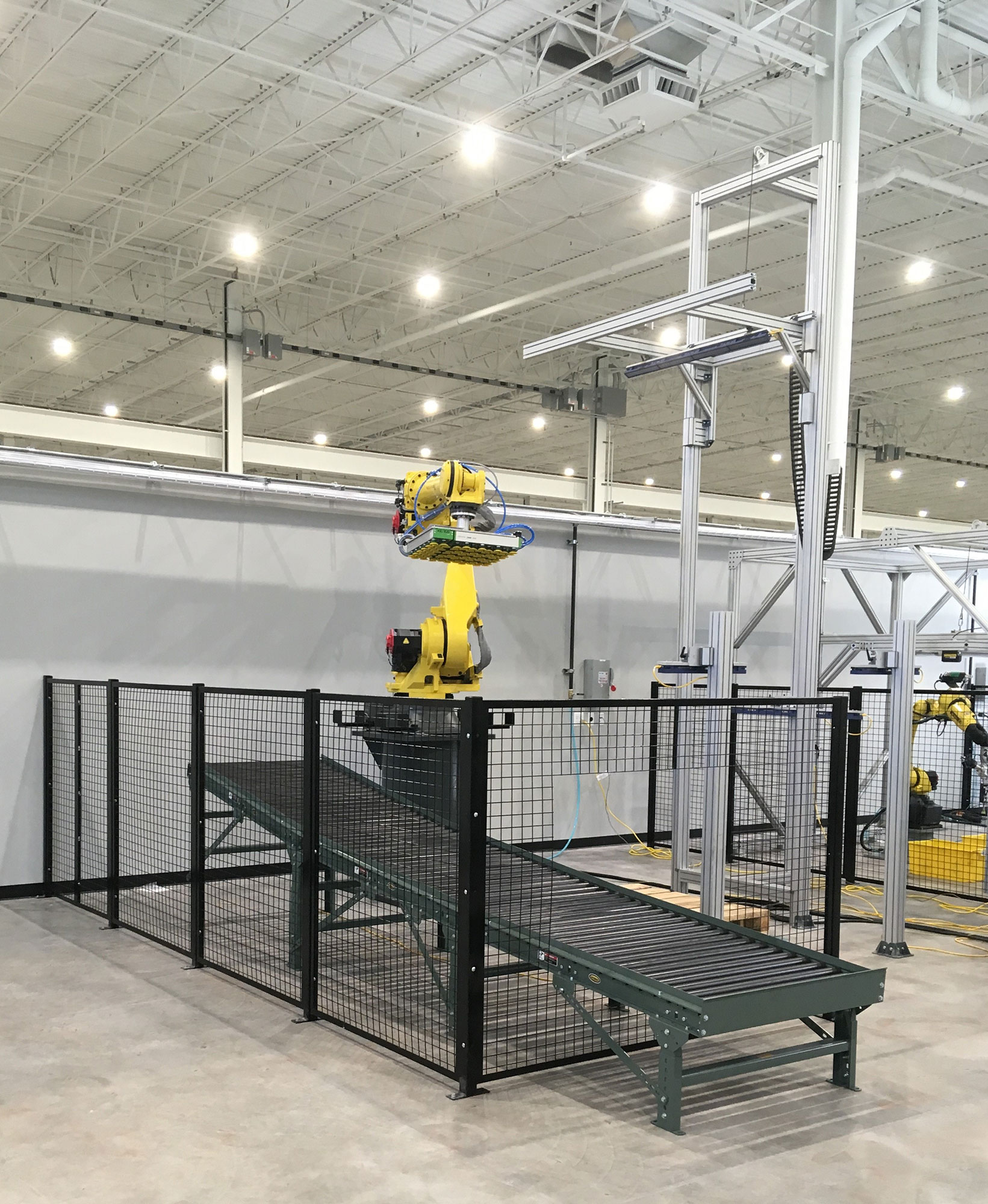
Robotic Guarding
Wire mesh automation guarding cages are a critical component in ensuring workplace safety in industrial settings. These cages consist of welded wire mesh enclosures that provide a physical barrier between workers and the moving parts of automated machinery and robots. The use of automation guarding cages is essential for preventing accidental contact with hazardous equipment and ensuring compliance with safety regulations.
Robotic Guarding Types
- 25” x 4” wire mesh
- Framed 2” x 2” wire mesh
Robotic Guarding Sizes
- Standard panels are 5′ wide, and 6′, 7′, 8′ tall, field modified.
- BeastWire description
Robotic Guarding
Wire mesh automation guarding cages are a critical component in ensuring workplace safety in industrial settings. These cages consist of welded wire mesh enclosures that provide a physical barrier between workers and the moving parts of automated machinery and robots. The use of automation guarding cages is essential for preventing accidental contact with hazardous equipment and ensuring compliance with safety regulations.

Robotic Guarding Types
- 25” x 4” wire mesh
- Framed 2” x 2” wire mesh
Robotic Guarding Sizes
- Standard panels are 5′ wide, and 6′, 7′, 8′ tall, field modified.
- BeastWire description
Robotic Guarding Applications
Robot Work Cells
Robotic guarding is commonly used to enclose robot work cells, creating a physical barrier around the area where robots operate. This ensures that workers are protected from moving robot arms, rotating equipment, and other potential hazards within the work cell.
Conveyor Systems
Guarding can be applied to safeguard workers around conveyor systems, especially in industries like manufacturing, packaging, and warehousing. Guards are used to prevent access to the conveyor belts, rollers, and other moving parts that could pose risks to workers.
Welding Applications
Robotic guarding is crucial in welding applications where robotic welding arms are used. Guards are employed to prevent accidental contact with the welding arc and protect workers from sparks, heat, and flying debris.
Palletizing and Material Handling
When utilized in warehouses and distribution centers, robotic guarding ensures that workers are kept safe from the movements and actions of robotic systems involved in stacking, picking, and transferring materials.
Assembly Lines
Robotic guarding is utilized in assembly line operations, where robots perform tasks such as product assembly, fastening, and quality control. Guards are installed to create safe zones for workers, preventing accidental contact with moving robot arms and associated machinery.
Machine Tending
Machine tending is where robots handle the loading and unloading of machines such as CNC (Computer Numerical Control) machines, lathes, milling machines, and presses. Guards protect workers from the hazards associated with these machines during operation.
Packaging and Sorting
Robotic guarding is used in packaging and sorting applications, where robots handle the packaging, sorting, and inspection of products. Guards ensure worker safety by restricting access to robotic systems and preventing inadvertent contact.
Inspection and Testing
Robotic guarding is applied in inspection and testing applications, where robots are used for quality control, measurement, and testing of products or components. Guards keep workers safe from the movements and actions of the robots and provide a secure environment for inspections.
Collaborative Robots
Robotic guarding is used in collaborative robot applications, where humans and robots work together in shared workspaces. Guards help establish safe zones and prevent accidental collisions or contact between humans and robots.
Industries That Utilize Robotic Guarding
Manufacturing
Food Processing
3PL’s
Automotive Manufacturing
Pharmaceuticals
Distribution Centers
Injection Molding
Medical
Robotic Guarding Features
- Quick & Easy Assembly
- Minimal Components
- Customizable Sizes
- Easily Modified in the Field: Around existing utilities, conduit, etc.
- Quick-Ship Available
- Entry Interfaces with Machine Operation: Interlocks, light curtains, etc.
Robotic Guarding Benefits
Worker Safety
The primary benefit of robotic guarding is enhanced worker safety. Robots often operate at high speeds and have powerful movements, which can pose significant risks to human workers. Robotic guarding acts as a physical barrier between humans and robots, preventing accidental contact and minimizing the potential for injuries or accidents.
Accident Prevention
Robotic guarding helps prevent accidents by restricting access to hazardous areas. It ensures that workers cannot enter dangerous zones while the robots are in operation, reducing the risk of collisions, entanglement, or other accidents caused by human interference.
Compliance with Safety Standards
Implementing robotic guarding helps organizations comply with safety standards and regulations. Many industrial sectors have specific guidelines regarding the use of automation and robotics, including requirements for safeguarding workers. Robotic guarding demonstrates a commitment to safety and can assist in meeting regulatory compliance.
Increased Productivity
While the primary purpose of robotic guarding is safety, it can also contribute to increased productivity. By protecting workers from potential hazards, employees can work confidently and efficiently around robots without fear of accidents. This allows for smoother operations, reduced downtime due to injuries, and improved overall productivity.
Flexibility and Adaptability
Robotic guarding can be designed to be adaptable and flexible to accommodate various robotic systems and applications. Guarding systems can be customized to fit the specific needs and requirements of different robotic setups, making it easier to integrate safety measures into existing automation processes.
Cost Savings
While initial investment is required to implement robotic guarding, it can lead to long-term cost savings. By preventing accidents and injuries, organizations can avoid medical expenses, worker compensation claims, and potential legal liabilities. Additionally, improved productivity and reduced downtime can positively impact the bottom line.
Ease of Maintenance
Robotic guarding systems are designed for easy maintenance and access to robotic components. This allows for efficient servicing, repair, or reconfiguration of robotic systems while ensuring the continued safety of workers.
Robotic Guarding Pricing Structure
Below is information that will help National Material Handling provide you with an accurate quote for your new project.
APPLICATION
Machine or robot being enclosed or guarded.
ENCLOSURE DRAWING
Width, depth, and height
ATTACHMENT TO OTHER STRUCTURES
Will it be attached to an existing structure? If so, 1, 2, or 3 sides?
OTHER REQUIREMENTS
Number of doors or access points, lock types, etc.
Robotic Guarding FAQs
Will the Machine Guarding meet code?
Yes, the guarding can be designed to meet code based on things such as distance from hazard, wire mesh opening, sweep space and hardware attachment.
Is machine guarding customizable?
Yes, panels and doors can be designed for your specific application or stock panels can easily be field cut to meet your specific requirements or project schedule.
How does Machine Guarding ship?
Guarding is shipped on custom A-frame pallets to ensure that all components arrive damage free.
Is Machine Guarding relocatable or reconfigurable?
Yes, the systems are completely modular with the ability to relocate and reconfigure whenever necessary.
Do you provide interlocks?
Yes, we have an optional interlock, electric strike, or light curtain that can be wired to cease equipment operation upon entry.
Does the order come with the required hardware to assemble?
Yes, each order will include the required hardware for installation of the product.
Are light curtains and/or laser scanners included?
These components are available as optional accessories.
Other Solutions
EMPLOYEE PRODUCTIVITY & WELL BEING
SPACE UTILIZATION & STORAGE
MATERIAL MOVEMENT
Site by tiny blue orange.
